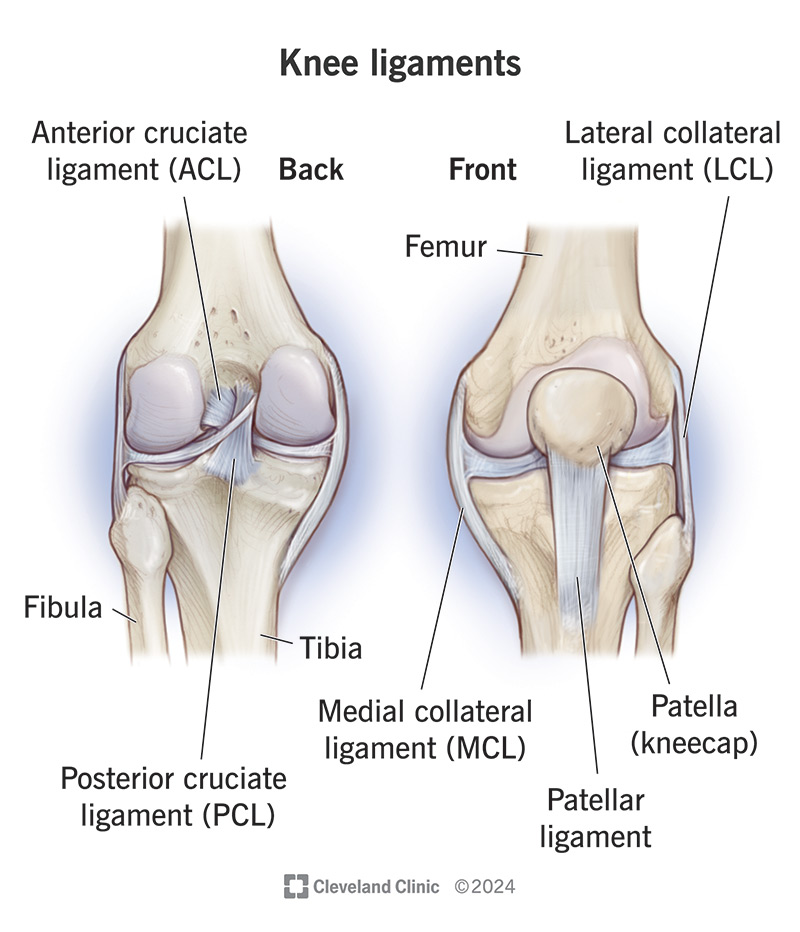Knee ligaments are bands of tissue that connect your thigh bone to your lower leg bones. They can be classified into two main groups: collateral ligaments and cruciate ligaments. Sprained and torn knee ligaments are common, especially among athletes. They may be mild, requiring rest and simple treatment, to severe, requiring surgery.
Advertisement
Cleveland Clinic is a non-profit academic medical center. Advertising on our site helps support our mission. We do not endorse non-Cleveland Clinic products or services. Policy

Your knee ligaments are rigid, supportive bands of soft tissue that connect your thigh bone (femur) in your upper leg to your lower leg bones (tibia and fibula). The ligaments of the knee hold your bones together and help stabilize your knee joint. They stabilize knee motion and brace your knees for unusual movement.
Advertisement
Cleveland Clinic is a non-profit academic medical center. Advertising on our site helps support our mission. We do not endorse non-Cleveland Clinic products or services. Policy
Although your knee ligaments are strong enough to hold your knee in place, they’re vulnerable to damage and injury. If you injure yourself or develop any pain in your knee ligaments, talk to your healthcare provider right away. Prompt treatment will get you moving again.
There are four main ligaments in your knee. The two collateral ligaments are like straps on each side of your knee. They prevent your knee from moving side to side too much. The two cruciate ligaments are in the center of your knee. They keep your knee from shifting too far forward or backward. The ligaments of the knee are:
Advertisement
Knee ligaments have several important jobs. They play a vital role in the functioning of your knee. Knee ligaments:
Your collateral ligaments are located on the sides of your knee. Your medial collateral ligament (MCL) is on the inner side and your lateral collateral ligament (LCL) is on the outer side.
Your anterior cruciate ligament (ACL) and posterior cruciate ligament (PCL) are located inside your knee joint toward the front of your knee. Your PCL crosses behind your ACL, forming an “X.”
Knee ligaments are made of strong connective tissue. They contain collagen — a protein that binds tissue in animals — and elastic fibers that are slightly stretchy.
An injury to a knee ligament is called a sprain (overstretched) or complete rupture (tear). Many knee sprains are mild, but torn knee ligaments can be severe. Knee ligament tears include:
Knee ligament injuries are common, especially in athletes. You can overstretch or tear a knee ligament when:
If you seek medical attention for a knee injury, a healthcare provider may:
Treatment for a knee sprain or torn ligament can vary greatly, depending on:
Treatment may range from nonsurgical to surgical:
Advertisement
You can’t prevent all knee injuries, but you can take steps to keep your knee ligaments safer, especially during physical activity. Steps you can take include:
Your knee ligaments are an important part of your knee anatomy. They help keep your knee in place and stabilize the joint. But they’re made of connective tissue that’s easily susceptible to sprains and tears. Talk to a healthcare provider if you have a severe knee injury or repeat injuries. Proper diagnosis and treatment can help prevent pain and future injuries.
Advertisement
From sudden injuries to chronic conditions, Cleveland Clinic’s orthopaedic providers can guide you through testing, treatment and beyond.

Last reviewed on 12/03/2024.
Learn more about the Health Library and our editorial process.